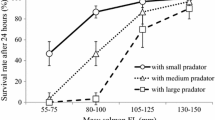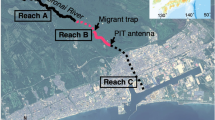Abstract
In general, hatchery salmonid smolts experience higher mortality during migration than wild smolts, which is suggested to be due to domestication effects and that hatchery fish lack experience of the natural environment. However, possible differences in feeding during smolt migration between hatchery and wild smolts have rarely been addressed. We compared the number of feeding smolts and stomach fullness among wild Atlantic salmon smolts, hatchery-reared smolts released as 1-year-old parr, and hatchery-reared smolts released as 2-year-old smolts during their descent to sea in River Tornionjoki. In addition, estimations of prey selection among the smolt groups were conducted. A high proportion of wild smolts and smolts stocked as parr actively fed during the smolt migration. A lower proportion of smolts stocked as smolts was feeding and their stomach fullness were much reduced in comparison with the two other groups. The study also indicated that the feeding of migrating smolts is selective rather than opportunistic. In conclusion, this study suggests that stocked 2-year-old smolts may enter sea with an inferior foraging behaviour and it is a possibility that this may contribute to the observed low post-smolt survival in the Baltic Sea.



Similar content being viewed by others
References
Aarestrup K, Koed A (2003) Survival of migrating sea trout (Salmo trutta) and Atlantic salmon (Salmo salar) smolts negotiating weirs in small Danish rivers. Ecol Freshw Fish 12:169–176
Allan JD, Russek E (1985) The quantification of stream drift. Can J Fish Aquat Sci 42:210–215
Andreassen PMR, Martinussen MB, Hvidsten NA, Stefansson SO (2001) Feeding and prey-selection of wild Atlantic salmon post-smolts. J Fish Biol 58:1667–1679
Berejikian BA, Tezak EP, Flagg TA, LaRae AL, Kummerow E, Mahnken CVW (2000) Social dominance, growth, and habitat use of age-0 steelhead (Oncorhynchus mykiss) grown in enriched and conventional hatchery rearing environments. Can J Fish Aquat Sci 57:628–636
Berglund I (1995) Effects of size and spring growth on sexual maturation in 1+ Atlantic salmon (Salmo salar) male parr: Interactions with smoltification. Can J Fish Aquat Sci 52:2682–2694
Bohlin T, Dellefors C, Faremo U (1996) Date of smelt migration depends on body-size but not age in wild sea-run brown trout. J Fish Biol 49:157–164
Brockmark S, Neregard L, Bohlin T, Björnsson BT, Johnsson JI (2007) Effects of rearing density and structural complexity on the pre- and postrelease performance of Atlantic salmon. T Am Fish Soc 136:1453–1462
Brown C, Laland K (2001) Social learning and life skills training for hatchery reared fish. J Fish Biol 59:471–493
Chesson J (1978) Measuring preference in selective predation. Ecol 59:211–215
Chesson J (1983) The estimation and analysis of preference and its relationship to foraging models. Ecol 64:1297–1304
Chittenden CM, Sura S, Butterworth KG, Cubitt KF, Manel-la NP, Balfry S, Økland F, McKinley RS (2008) Riverine, estuarine and marine migratory behaviour and physiology of wild and hatchery-reared coho salmon Oncorhynchus kisutch (Walbaum) smolts descending the Campbell River, BC, Canada. J Fish Biol 72:614–628
Elliott JM (1991) Rates of gastric evacuation in piscivorous brown trout, Salmo trutta. Freshw Biol 25:297–305
Fulton TW (1904) The rate of growth of fishes. Fish Board Scotland Annu Rep 22:141–241
Garnås E, Hvidsten NA (1985) The food of Atlantic salmon Salmo salar L. and brown trout Salmo trutta L. smolts during migration in the Orkla river, Norway. Fauna Norv A 6:24–28
Gross MR, Coleman RM, McDowall RM (1988) Aquatic productivity and the evolution of diadromous fish migration. Science 239:1291–1293
Haikonen A, Romakkaniemi A, Keinänen M, Linnansaari T, Mäntyniemi S, Pasternack M, Vatanen S (2002) Monitoring of the salmon and trout stocks in the River Tornionjoki in 2001. Finnish Game and Fisheries Research Institute, Rep. No. 250. [Summary in English]
Hansen LP, Pethon P (1985) The food of Atlantic salmon Salmo salar L., caught by long-line in the northern Norwegian waters. J Fish Biol 26:553–562
Heinimaa S, Erkinaro J (1999) Fast-flowing areas affect the feeding activity of migrating Atlantic salmon smolts in tributaries of a subarctic river. J Fish Biol 54:688–690
Huntingford FA (2004) Implications of domestication and rearing conditions for the behaviour of cultivated fishes. J Fish Biol 65:122–142
Hynes HBN (1950) The food of fresh-water sticklebacks (Gasterosteus aculeatus and Pygosteus pungitius), with a review of methods used in studies of the food of fishes. J Anim Ecol 19:36–58
ICES (2008) Report of the Baltic Salmon and Trout Working Group (WGBAST). ICES CM 2008/ACOM:05. 267 pp
Jepsen N, Aarestrup K, Okland F, Rasmussen G (1998) Survival of radio-tagged Atlantic salmon (Salmo salar L.) and trout (Salmo trutta L.) smolts passing a reservoir during seaward migration. Hydrobiologia 372:347–353
Johnson JH, McKeon JF, Dropkin DS (1996) Comparative diets of hatchery and wild Atlantic salmon smolts in the Merrimack River. N Am J Fish Manag 16:440–444
Jonsson B, Jonsson N (2006) Cultured Atlantic salmon in nature: a review of their ecology and interaction with wild fish. ICES J Mar Sci 63:1162–1181
Jonsson B, Jonsson N (2009) Restoration and Enhancement of Salmonid Populations and Habitats with Special Reference to Atlantic Salmon. In: Haro A, Smith KL, Rulifson RA, Moffitt CM, Klauda RJ, Dadswell MJ, Cunjak RA, Cooper JE, Beal KL, Avery TS (eds) Challenges for diadromous fishes in a dynamic global environment. American Fisheries Society Symposium, pp 497–535
Jonsson N, Jonsson B, Hansen LP (2003) The marine survival and growth of wild and hatchery reared Atlantic salmon. J Appl Ecol 40:900–911
Kallio-Nyberg I, Salminen M, Saloniemi I, Kannala-Fisk L (2009) Marine survival of reared Atlantic salmon in the Baltic Sea: The effect of smolt traits and annual factors. Fish Res 96:289–295
Koed A, Baktoft H, Bak BD (2006) Causes of mortality of Atlantic salmon (Salmo salar) and brown trout (Salmo trutta) smolts in a restored river and its estuary. River Res Appl 22:69–78
Lima SL, Dill LM (1990) Behavioural decisions made under the risk of predation: a review and prospectus. Can J Zool 68:619–640
McCormick SD, Hansen LP, Quinn TP, Saunders RL (1998) Movement, migration, and smolting of Atlantic salmon (Salmo salar). Can J Fish Aquat Sci 55:77–92
Mikheev VN (1984) Prey size and food selectivity in young fishes. J Ichthyol 24:66–76
Mitans AR (1970) The feeding of Baltic salmon smolts in the river and in the sea. J Ichthyol 10:89–95
Olla BL, Davis MW, Ryer CH (1994) Behavioural deficits in hatchery-reared fish: potential effects on survival following release. Aquacult Fish Manage 25:19–34
Puro-Tahvanainen A, Viitala L, Lundvall D, Brännström G, Lundstedt L (2001) The River Tornio—state and loading of river system. Lapland Regional Environment Centre and County Administrative Board of Norrbotten, Rovaniemi, Finland. Reg Environ Publ 95:1–242
Romakkaniemi A (2008) Conservation of Atlantic salmon by supplementary stocking of juvenile fish. Dissertation, University of Helsinki
Saloniemi I, Jokikokko E, Kallio-Nyberg I, Jutila E, Pasanen P (2004) Survival of reared and wild Atlantic salmon smolts: size matters more in bad years. ICES J Mar Sci 61:782–787
Saunders RL, Henderson EB (1970) Influence of photoperiod on smolt development and growth of atlantic salmon (Salmo salar). J Fish Res Board Can 27:1295–1311
Serrano I, Larsson S, Eriksson L-O (2009a) Migration performance of wild and hatchery sea trout (Salmo trutta L.) smolts - implications for compensatory hatchery programs. Fish Res 99:210–215
Serrano I, Rivinoja P, Karlsson L, Larsson S (2009b) Riverine and early marine survival of stocked salmon smolts, Salmo salar L., descending the Testebo River, Sweden. Fish Manag Ecol 16:386–394
Skilbrei OT (1991) Importance of threshold length and photoperiod for the development of bimodal length frequency-distribution in Atlantic salmon (Salmo salar). Can J Fish Aquat Sci 48:2163–2172
Sosiak AJ, Randall RG, McKenzie JA (1979) Feeding by hatchery-reared and wild Atlantic salmon (Salmo salar) parr in streams. J Fish Res Board Can 36:1408–1412
Sturlaugsson J (1994) Food of ranched Atlantic salmon (Salmo salar L.) postsmolts in coastal waters, W-Iceland. Nord J Freshw Res 69:43–57
Virtanen E (1988) Smolting and osmoregulation of Baltic salmon, Salmo salar L., in fresh and brackish water. Finn Fish Res 7:38–65
Wankowski JWJ (1981) Behavioural aspects of predation by juvenile Atlantic salmon. Anim Behav 29:557–571
Wankowski JWJ, Thorpe JE (1979) The role of food particle size in growth of juvenile Atlantic salmon (Salmo salar). J Fish Biol 14:351–370
Weber ED, Fausch KD (2003) Interactions between hatchery and wild salmonids in streams: differences in biology and evidence for competition. Can J Fish Aquat Sci 60:1018–1036
Werner EE, Anholt BR (1993) Ecological consequences of the trade-off between growth and mortality rates mediated by foraging activity. Am Nat 142:242–272
Zydlewski GB, Foott JS, Nichols K, Hamelberg S, Zydlewski J, Björnsson BT (2003) Enhanced smolt characteristics of steelhead trout exposed to alternative hatchery conditions during the final months of rearing. Aquaculture 222:101–117
Acknowledgements
We thank A. Romakkaniemi for helpful advice and logistical support during the study. J. and H. Erkinaro and late P. Kreivi provided useful comments on the early draft of this manuscript.
Author information
Authors and Affiliations
Corresponding author
Rights and permissions
About this article
Cite this article
Larsson, S., Linnansaari, T., Vatanen, S. et al. Feeding of wild and hatchery reared Atlantic salmon (Salmo salar L.) smolts during downstream migration. Environ Biol Fish 92, 361–369 (2011). https://doi.org/10.1007/s10641-011-9846-7
Received:
Accepted:
Published:
Issue Date:
DOI: https://doi.org/10.1007/s10641-011-9846-7




